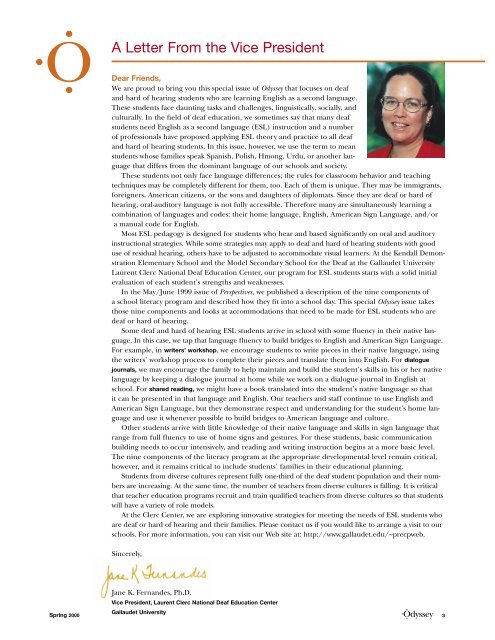Deaf ESL Students - Gallaudet University
Deaf ESL Students - Gallaudet University
Deaf ESL Students - Gallaudet University
You also want an ePaper? Increase the reach of your titles
YUMPU automatically turns print PDFs into web optimized ePapers that Google loves.
Spring 2000<br />
A Letter From the Vice President<br />
Dear Friends,<br />
We are proud to bring you this special issue of Odyssey that focuses on deaf<br />
and hard of hearing students who are learning English as a second language.<br />
These students face daunting tasks and challenges, linguistically, socially, and<br />
culturally. In the field of deaf education, we sometimes say that many deaf<br />
students need English as a second language (<strong>ESL</strong>) instruction and a number<br />
of professionals have proposed applying <strong>ESL</strong> theory and practice to all deaf<br />
and hard of hearing students. In this issue, however, we use the term to mean<br />
students whose families speak Spanish, Polish, Hmong, Urdu, or another language<br />
that differs from the dominant language of our schools and society.<br />
These students not only face language differences; the rules for classroom behavior and teaching<br />
techniques may be completely different for them, too. Each of them is unique. They may be immigrants,<br />
foreigners, American citizens, or the sons and daughters of diplomats. Since they are deaf or hard of<br />
hearing, oral-auditory language is not fully accessible. Therefore many are simultaneously learning a<br />
combination of languages and codes: their home language, English, American Sign Language, and/or<br />
a manual code for English.<br />
Most <strong>ESL</strong> pedagogy is designed for students who hear and based significantly on oral and auditory<br />
instructional strategies. While some strategies may apply to deaf and hard of hearing students with good<br />
use of residual hearing, others have to be adjusted to accommodate visual learners. At the Kendall Demonstration<br />
Elementary School and the Model Secondary School for the <strong>Deaf</strong> at the <strong>Gallaudet</strong> <strong>University</strong><br />
Laurent Clerc National <strong>Deaf</strong> Education Center, our program for <strong>ESL</strong> students starts with a solid initial<br />
evaluation of each student’s strengths and weaknesses.<br />
In the May/June 1999 issue of Perspectives, we published a description of the nine components of<br />
a school literacy program and described how they fit into a school day. This special Odyssey issue takes<br />
those nine components and looks at accommodations that need to be made for <strong>ESL</strong> students who are<br />
deaf or hard of hearing.<br />
Some deaf and hard of hearing <strong>ESL</strong> students arrive in school with some fluency in their native language.<br />
In this case, we tap that language fluency to build bridges to English and American Sign Language.<br />
For example, in writers’ workshop, we encourage students to write pieces in their native language, using<br />
the writers’ workshop process to complete their pieces and translate them into English. For dialogue<br />
journals, we may encourage the family to help maintain and build the student’s skills in his or her native<br />
language by keeping a dialogue journal at home while we work on a dialogue journal in English at<br />
school. For shared reading, we might have a book translated into the student’s native language so that<br />
it can be presented in that language and English. Our teachers and staff continue to use English and<br />
American Sign Language, but they demonstrate respect and understanding for the student’s home language<br />
and use it whenever possible to build bridges to American language and culture.<br />
Other students arrive with little knowledge of their native language and skills in sign language that<br />
range from full fluency to use of home signs and gestures. For these students, basic communication<br />
building needs to occur intensively, and reading and writing instruction begins at a more basic level.<br />
The nine components of the literacy program at the appropriate developmental level remain critical,<br />
however, and it remains critical to include students’ families in their educational planning.<br />
<strong>Students</strong> from diverse cultures represent fully one-third of the deaf student population and their numbers<br />
are increasing. At the same time, the number of teachers from diverse cultures is falling. It is critical<br />
that teacher education programs recruit and train qualified teachers from diverse cultures so that students<br />
will have a variety of role models.<br />
At the Clerc Center, we are exploring innovative strategies for meeting the needs of <strong>ESL</strong> students who<br />
are deaf or hard of hearing and their families. Please contact us if you would like to arrange a visit to our<br />
schools. For more information, you can visit our Web site at: http://www.gallaudet.edu/~precpweb.<br />
Sincerely,<br />
Jane K. Fernandes, Ph.D.<br />
Vice President, Laurent Clerc National <strong>Deaf</strong> Education Center<br />
<strong>Gallaudet</strong> <strong>University</strong><br />
3
















